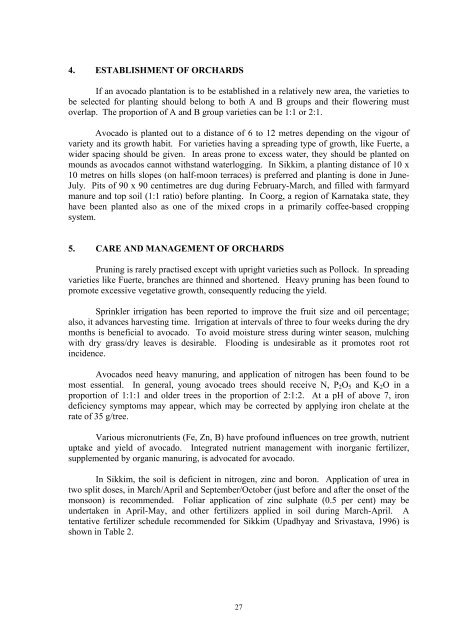Avocado Production in Asia and the Pacific - United Nations in ...
Avocado Production in Asia and the Pacific - United Nations in ...
Avocado Production in Asia and the Pacific - United Nations in ...
You also want an ePaper? Increase the reach of your titles
YUMPU automatically turns print PDFs into web optimized ePapers that Google loves.
4. ESTABLISHMENT OF ORCHARDS<br />
If an avocado plantation is to be established <strong>in</strong> a relatively new area, <strong>the</strong> varieties to<br />
be selected for plant<strong>in</strong>g should belong to both A <strong>and</strong> B groups <strong>and</strong> <strong>the</strong>ir flower<strong>in</strong>g must<br />
overlap. The proportion of A <strong>and</strong> B group varieties can be 1:1 or 2:1.<br />
<strong>Avocado</strong> is planted out to a distance of 6 to 12 metres depend<strong>in</strong>g on <strong>the</strong> vigour of<br />
variety <strong>and</strong> its growth habit. For varieties hav<strong>in</strong>g a spread<strong>in</strong>g type of growth, like Fuerte, a<br />
wider spac<strong>in</strong>g should be given. In areas prone to excess water, <strong>the</strong>y should be planted on<br />
mounds as avocados cannot withst<strong>and</strong> waterlogg<strong>in</strong>g. In Sikkim, a plant<strong>in</strong>g distance of 10 x<br />
10 metres on hills slopes (on half-moon terraces) is preferred <strong>and</strong> plant<strong>in</strong>g is done <strong>in</strong> June-<br />
July. Pits of 90 x 90 centimetres are dug dur<strong>in</strong>g February-March, <strong>and</strong> filled with farmyard<br />
manure <strong>and</strong> top soil (1:1 ratio) before plant<strong>in</strong>g. In Coorg, a region of Karnataka state, <strong>the</strong>y<br />
have been planted also as one of <strong>the</strong> mixed crops <strong>in</strong> a primarily coffee-based cropp<strong>in</strong>g<br />
system.<br />
5. CARE AND MANAGEMENT OF ORCHARDS<br />
Prun<strong>in</strong>g is rarely practised except with upright varieties such as Pollock. In spread<strong>in</strong>g<br />
varieties like Fuerte, branches are th<strong>in</strong>ned <strong>and</strong> shortened. Heavy prun<strong>in</strong>g has been found to<br />
promote excessive vegetative growth, consequently reduc<strong>in</strong>g <strong>the</strong> yield.<br />
Spr<strong>in</strong>kler irrigation has been reported to improve <strong>the</strong> fruit size <strong>and</strong> oil percentage;<br />
also, it advances harvest<strong>in</strong>g time. Irrigation at <strong>in</strong>tervals of three to four weeks dur<strong>in</strong>g <strong>the</strong> dry<br />
months is beneficial to avocado. To avoid moisture stress dur<strong>in</strong>g w<strong>in</strong>ter season, mulch<strong>in</strong>g<br />
with dry grass/dry leaves is desirable. Flood<strong>in</strong>g is undesirable as it promotes root rot<br />
<strong>in</strong>cidence.<br />
<strong>Avocado</strong>s need heavy manur<strong>in</strong>g, <strong>and</strong> application of nitrogen has been found to be<br />
most essential. In general, young avocado trees should receive N, P 2 O 5 <strong>and</strong> K 2 O <strong>in</strong> a<br />
proportion of 1:1:1 <strong>and</strong> older trees <strong>in</strong> <strong>the</strong> proportion of 2:1:2. At a pH of above 7, iron<br />
deficiency symptoms may appear, which may be corrected by apply<strong>in</strong>g iron chelate at <strong>the</strong><br />
rate of 35 g/tree.<br />
Various micronutrients (Fe, Zn, B) have profound <strong>in</strong>fluences on tree growth, nutrient<br />
uptake <strong>and</strong> yield of avocado. Integrated nutrient management with <strong>in</strong>organic fertilizer,<br />
supplemented by organic manur<strong>in</strong>g, is advocated for avocado.<br />
In Sikkim, <strong>the</strong> soil is deficient <strong>in</strong> nitrogen, z<strong>in</strong>c <strong>and</strong> boron. Application of urea <strong>in</strong><br />
two split doses, <strong>in</strong> March/April <strong>and</strong> September/October (just before <strong>and</strong> after <strong>the</strong> onset of <strong>the</strong><br />
monsoon) is recommended. Foliar application of z<strong>in</strong>c sulphate (0.5 per cent) may be<br />
undertaken <strong>in</strong> April-May, <strong>and</strong> o<strong>the</strong>r fertilizers applied <strong>in</strong> soil dur<strong>in</strong>g March-April. A<br />
tentative fertilizer schedule recommended for Sikkim (Upadhyay <strong>and</strong> Srivastava, 1996) is<br />
shown <strong>in</strong> Table 2.<br />
27
















